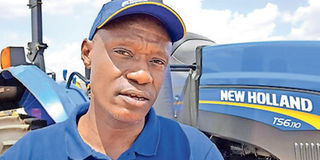Place of machinery on the modern farm

Alexander Mutua Makaa, the CMC Motors Group Limited divisional manager New Holland. He encourages farmers to embrace research and collaboration approach with available institutions that have invested funds to promote mechanisation, in line with the manufacturer’s recommendations. PHOTO | COURTESY
What you need to know:
- The government has put in place measures to zero-rate farming equipment to enhance affordability.
- The government is involved in a programme with local stakeholders to enhance the implementation of the Big Four value chain that cuts across tractors, implements, dryers, shellers and coolers by offering leasing options starting 2019.
- Agriculture is one of the key sectors where farmers have reviewed and researched applications and equipment that would best suit their endeavours.
- The government further has invested in institutions such as Kalro that carry out researches and would advise on the best practices in agriculture subject to the region, soil and weather conditions.
Alexander Mutua Makaa is the CMC Motors Group Limited divisional manager New Holland. He spoke to Brian Okinda on the place of mechanisation in modern farming
What is the place of farm machinery and mechanisation in contemporary farming?
Machinery is key to improve efficiency and productivity, starting from subsistence farmers to commercial ones because demand for food is ever rising.
The government has put in place measures to zero-rate farming equipment to enhance affordability. You can now do any kind of farm work using machines, from tilling land, planting and harvesting and even milking animals.
Some farmers have adapted themselves to working without machinery because of their exorbitant costs. How can these farmers be enabled to acquire machinery?
The government has collaborations with various financial institutions such as Industrial Development Fund and African Finance Corporations, among others, who have tailor-made finance solutions that look into farmer’s requirements and guarantee flexibility in offering fixed interest charges, extended repayment plans for up to 48 months, seasonal payment schemes and minimum deposit requirements.
The government is involved in a programme with local stakeholders to enhance the implementation of the Big Four value chain that cuts across tractors, implements, dryers, shellers and coolers by offering leasing options starting 2019.
In our case, we are currently engaged with all banking institutions to facilitate asset finance loans at the capped interest rate of 13.5 per cent.
For small-scale farmers, we are involved in discussions with the government to look into strategic partnerships with the Ministry of Agriculture to drive value addition services such as leasing.
What are some of the machinery that are a must-have for any farmer, whether they are smallholders or large-scale?
An average tractor within the 40—80Hp range complete with tilling, planting, weeding, spraying and harvesting implements. A tractor drawn farm trailer (4—8 tonne) to collect produce from the farms to the target market.
Irrigation implements where water is not readily available.
What is your take on some farmers being creative and setting up their own mechanisation systems on the farm or modifying their machinery to be able to perform other duties?
Agriculture is one of the key sectors where farmers have reviewed and researched applications and equipment that would best suit their endeavours.
Creativity mixed with expert advice is a crucial mix in acquiring enhanced mechanisation systems that work and promote efficiency and high productivity in the agricultural segment.
The government further has invested in institutions such as Kalro that carry out researches and would advise on the best practices in agriculture subject to the region, soil and weather conditions.
I would encourage farmers to embrace research and collaboration approach with available institutions that have invested funds to promote mechanisation, in line with the manufacturer’s recommendations.
This will protect the farmer against unpredicted breakage or under productivity.





